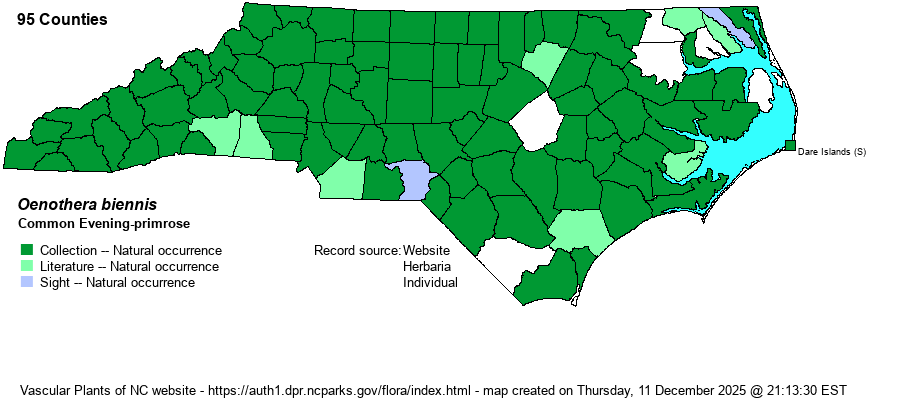| Author | L. | |
| Distribution | Statewide, though oddly spotty in the northeastern corner of the state. However, presumed to occur in all 100 counties.
This is a very widespread species of the Eastern part of the continent, found in nearly every county in the range. | |
| Abundance | Very common across the Mountains, Piedmont, and most of the Coastal Plain, but infrequent in the far northeastern corner. | |
| Habitat | This is a species of edges and openings, in a great array for moisture and soil. It is often seen along woodland borders, roadbanks, weedy fields, powerline clearings, and other clearings. |
| Phenology | Blooms from June to October, and fruits shortly after flowering. | |
| Identification | This is an easily found species by biologists and the public, almost too common to become interested in it. It is a robust, very tall herb, growing to 5-6 feet tall, mostly unbranched or with a few small branches near the top of the stem. The very numerous alternate leaves are very long, about 6-8 inches long and 1-2 inches wide, lanceolate to narrowly elliptic, with serrated margins. The inflorescences are terminal on branch ends, with individual flowers from the axils of the uppermost leaves, on long floral tubes over 1-inch long. The 4 petals are pale to medium yellow (but not rich yellow), about 1.5 inches long but ascending, such that the flower is about 1.5-2 inches broad. Even without the flowers, this is normally an easily identified species owing to its tall stem, with the stem often dark red, and the abundance of alternate, long leaves. However, there are two other tall species present in the state that are very similar and have in the past been included within it. O. nutans and O. parviflora also occur in NC, mainly in the mountains. See the species accounts for these for some character differences. Generally speaking, these two have smooth/hairless inflorescences, versus pubescent in O. biennis, and O. parviflora has flowers only half the size of the other two. | |
| Taxonomic Comments | Despite its very wide range, most references do not list varieties or subspecies for it.
| |
| Other Common Name(s) | Evening Primrose (but this is a generic name for the genus), Sundrop (a name used for several other species) | |
| State Rank | S5 | |
| Global Rank | G5 | |
| State Status | | |
| US Status | | |
| USACE-agcp | FACU link |
| USACE-emp | FACU link |

